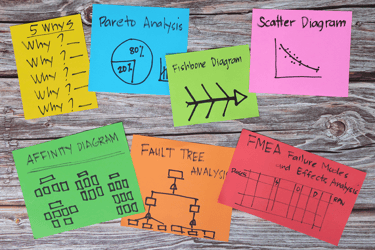The Packaging Industry's Sustainability Challenge: Why ERP Systems Are Essential for Success A straightforward guide to navigating sustainability regulations across folding carton, flexible...
Ready player one: Boosting operational efficiency across single and multi-site packaging environments with gamification
Gamification is becoming a revolutionary approach in the packaging industry, where productivity and efficiency are crucial for success.
This strategy utilizes game design principles to motivate and engage workers, improving individual and collective performance. Gamification involves integrating various gaming elements, such as challenges, rewards, and points systems, into work processes to motivate employees and give them a sense of achievement.
The following article explains how gamification can be applied in packaging companies with a single plant or multiple sites and its impact on operations.
Contents
- Understanding Gamification in Packaging Operations
- Single Plant Implementation
- Multi-Site Implementation
- Cultural Shift and Employee Engagement
- Examples of Targets and Metrics
- Gamification’s Value for Packaging Businesses
- ePS’s Role in Implementing Gamification in a Packaging Enterprise
Understanding Gamification in Packaging Operations
Gamification involves integrating game mechanics into the workplace to boost motivation and enhance performance. In some cases, gamification can be particularly advantageous for organizations that aim to improve operational efficiency or minimize waste. By using Key Performance Indicators (KPIs) like Overall Equipment Effectiveness (OEE), teams and individuals can track their progress and engage in friendly competition, helping to increase their intrinsic motivation and drive to succeed.
Single Plant Implementation
In a single plant scenario, gamification can be used to compare different shifts or machine operators within the same department. For instance, displaying real-time data on dashboards in common areas like break rooms or at the entrance to the production floor allows employees to see their performance compared to their peers. This data can include metrics such as:
- Efficiency rates
- Waste levels
- Schedule automation level
- Schedule adherence and attainment
- Carbon footprint and other sustainability targets
Such visibility promotes healthy competition among workers and encourages each team to strive for higher productivity and less downtime, thus aligning individual goals with business objectives.
Multi-Site Implementation
For businesses with multiple sites, gamification can extend to inter-plant comparisons. Here, each site's performance data can be benchmarked against others, encouraging plants to outperform internal targets and those set by sister plants. This data could include:
- Comparative efficiency and waste reduction metrics across similar departments but different locations
- ROI calculations based on improvements in goods quality or reductions in carbon footprint
Integrating these metrics into an enterprise-level dashboard allows senior management to access and interpret complex data, facilitating strategic decision-making.
Cultural Shift and Employee Engagement
Implementing gamification leads to a cultural shift within the organization. Staff often enjoy the challenges and opportunities to ‘gamify’ their work environment. This shift is particularly well-received by a younger workforce accustomed to digital interaction and feedback. Such strategies reduce the resistance typically associated with monitoring and performance management, as they bring a transparent, inclusive, and rewarding approach to employee evaluation.
Examples of Targets and Metrics
Efficiency Improvement:- Machine speed optimization: Setting specific targets for increasing the number of units produced per hour.
- Setup time reduction: Incentivizing operators to decrease the time to switch from one production batch to another, thus reducing idle machine time.
- Material usage efficiency: Setting targets for reduced material wastage per production run; this could involve more precise cutting techniques or better handling of raw material.
- Recycling initiatives: Rewarding teams for increasing the percentage of recycled waste, thereby supporting sustainability efforts.
- Decrease defect rates: Rewarding operators for producing jobs with fewer defects; this could involve careful monitoring of machinery settings or more stringent quality checks.
- Customer complaints: Setting targets to reduce the number of customer complaints related to product quality, encouraging more attention to detail.
- Reduction in energy per unit: Setting goals for reducing the energy consumed per production unit; this could involve optimizing machine operations or scheduling production runs during off-peak energy hours.
- Sustainable practices reward: Incentivizing the use of renewable energy sources or implementing energy-saving measures within the plant.
- Inventory turnover: Incentivizing teams to increase inventory turnover rates - optimizing the balance between inventory levels and production needs.
- Schedule adherence: Rewarding adherence to production schedules, minimizing delays, and ensuring smoother operations across shifts.
Gamification’s Value for Packaging Businesses
The strategic implementation of gamification in packaging operations presents numerous tangible and intangible benefits that significantly contribute to the overall health and competitiveness of the business:
- Increased Productivity: By turning work processes into a competitive game, employees are naturally inclined to optimize their performance. As teams and individuals strive to outdo each other or beat their previous bests, overall productivity rises, directly benefiting output and operational efficiency.
- Reduced Costs: Enhanced productivity and efficiency lead directly to lower operational costs. For example, reducing machine downtime and minimizing waste production can significantly save material costs and maintenance. Additionally, improved process adherence can decrease the incidence of costly errors and reworks.
- Enhanced Employee Satisfaction and Retention: Gamification introduces an element of fun and recognition into the workplace, which can significantly boost employee morale and job satisfaction. Recognizing and rewarding employees for their achievements can lead to higher engagement levels, reducing turnover rates and the costs associated with hiring and training new staff.
- Data-Driven Decisions: With gamification, every aspect of the operations becomes measurable, providing management with a wealth of data about how machines and employees perform under varying conditions. This rich dataset enables managers to make informed decisions, identify best practices, and replicate success across shifts and plants.
- Cultural Transformation: Gamification can foster a culture of continuous improvement and innovation. It encourages a problem-solving mindset and closer collaboration among teams as employees share strategies and insights to improve their scores on the leaderboards.
- Improved Compliance and Quality: By incorporating quality metrics into the gamification system, companies can incentivize adherence to compliance standards and quality control measures. This reduces the risk of non-compliance penalties and ensures that the product quality remains high - enhancing customer satisfaction and loyalty.
- Sustainability and Resource Efficiency: In industries focusing on sustainability, gamification strategies can be aligned with environmental goals, such as reducing energy use or minimizing waste. This helps achieve regulatory compliance and Corporate Social Responsibility (CSR) goals and resonates well with environmentally conscious consumers.
ePS’s Role in Implementing Gamification in a Packaging Enterprise
ePS has a team of experts who can help formulate a gamification strategy to increase user engagement and automate workflows. The team has extensive experience onboarding and training users on all ePS Packaging Suite modules, including the Radius ERP environment, Auto-Count 4D shop floor data collection system, and PrintFlow 4D , a production scheduling application. This experience provides them with unique insights into how users interact with the software, and they can use this knowledge to deploy gamification elements effectively. For example, they can add challenges and achievements to motivate users to explore underused features and follow best practices.
Gamification transforms traditional packaging operations into dynamic and engaging environments. By aligning business objectives with employee motivations, companies can foster a competitive yet collaborative atmosphere that drives continuous improvement and operational excellence. This boosts productivity, efficiency, and cost savings and cultivates a culture of innovation and accountability. Furthermore, this approach can improve employee engagement and satisfaction, data-driven decision-making, and quality control. Finally, gamification is also scalable and adaptable to different operational goals and can even promote sustainability and corporate responsibility, which are essential for continued success in the competitive packaging industry.



